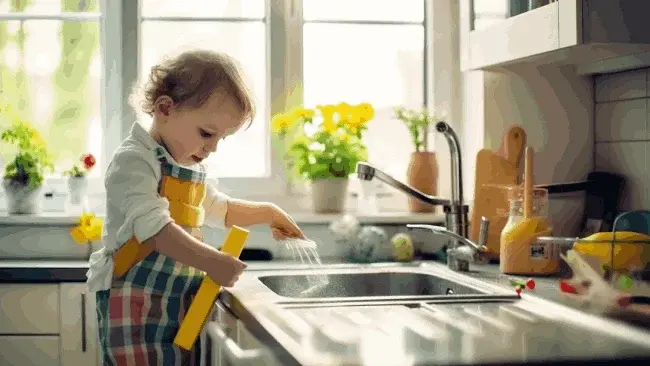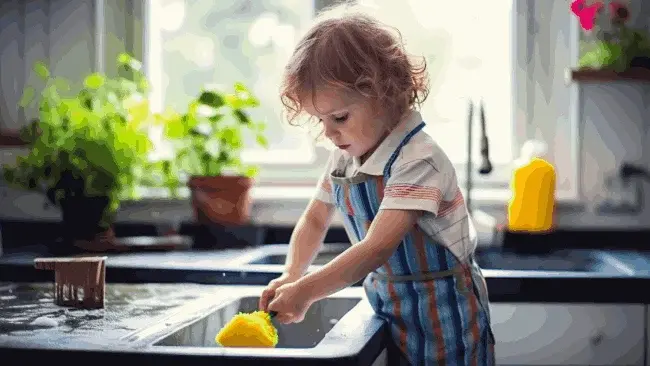Family-friendly kitchen routines that involve kids are both fun and beneficial for everyone. Involving your kids in these tasks helps keep your kitchen clean and organized, teaches them valuable life skills, and instills a sense of responsibility.
To involve kids in kitchen cleaning and organizing and create family-friendly kitchen routines, there are several key strategies that you should consider. One of the first things you should do is establish a kid-friendly kitchen space, ensure that dishes and utensils are accessible, and introduce safety rules.
This space will make kids feel more comfortable and confident while participating in kitchen tasks. We will discuss all aspects of involving your children in kitchen cleaning and organizing.
Jump to Section
Involving Kids in Kitchen Cleaning and Organizing: Things to Do

For involving kids in kitchen cleaning and organizing, you have to follow these things:
Now check out each aspect in detail to start involving your kids in kitchen cleaning and organizing and establish a family-friendly kitchen routine.
1. Create a Kid-Friendly Kitchen Space
To instill a love for cooking and a sense of responsibility in your children, consider creating a kid-friendly kitchen space. Start by storing kid-friendly dishes, cups, and utensils in lower cabinets. This allows your children to easily access and set the table as part of their responsibilities.
Establish snack stations with clear distinctions between everyday snacks and occasional treats to promote healthy snacking habits. Use visually appealing snack containers to create an organized and inviting pantry. Reusable storage containers are a great option for snacks, as they help with organization and reduce waste.
Also, keep step stools accessible in the kitchen to enhance your children’s reach and involvement in daily tasks. Creating a kid-friendly kitchen space will teach your children valuable skills and make them feel like an important part of the family’s routine.
2. Teach Your Kids Kitchen Safety, Cleaning and Organizing
When involving kids in the kitchen, prioritizing safety is paramount. Begin by integrating essential safety rules into your kitchen routine, emphasizing the need for adult supervision during any cooking or cleaning activities.
Stress the importance of refraining from touching the stove, sharp objects, or any potentially hazardous tools without proper guidance.
Cultivate the habit of thorough handwashing before engaging in kitchen tasks. To enhance accessibility without compromising safety, invest in secure step stools, discouraging the use of unstable surfaces.
In terms of cleaning, introduce your kids to a step-by-step guide to help them learn effective cleaning techniques using safe and child-friendly products.
Break down the cleaning process into three steps. Among these are: recognizing and wiping off dirt, using safe cleaning sprays and proper techniques to wipe counters, and ensuring appropriate disposal or washing of cleaning materials.
This structured approach educates kids on the cleaning process and instills a sense of responsibility and accomplishment.
Regarding kitchen organization, involve your kids by transforming it into an engaging and educational activity. Start by introducing them to the concept of categorization.
Teach them to identify and group similar items together, such as utensils, plates, and pantry items. Utilize colorful bins or labels to make the process visually appealing and easier to understand.
Encourage them to participate in arranging items in inaccessible and logical places, considering their height and reach. For instance, designate a lower shelf for their snacks or utensils, allowing them to access and put away their belongings independently.
Teach them the importance of keeping commonly used items within easy reach, promoting efficiency and orderliness. Also, involve them in periodic decluttering sessions, guiding them on sorting and donating items they no longer need.
3. Create a Routine and Assign Age-Appropriate Tasks

Creating a routine with age-appropriate tasks is a crucial step in involving your children in kitchen cleaning and organizing. This contributes to their skill development and instills a sense of responsibility in their contribution to household chores.
Children aged 2 and under can be assigned tasks such as closing cabinet doors, turning on the dishwasher, and setting the table. As they progress into the 3 to 5 age range, additional responsibilities such as placing dirty dishes on the kitchen counter, cleaning the play table, and unloading the dishwasher can be given to them.
For children aged 6 to 9, tasks expand to include helping make breakfast, performing simple cooking tasks, and setting and clearing the table. Also, cleaning up spills, sweeping or vacuuming the kitchen floor, putting groceries away, and emptying and wiping wastebaskets are suitable tasks for this age range.
More advanced responsibilities become suitable as they enter the 10 to 13 age group. For example, pouring beverages for meals, hand-washing dishes, making school lunches, and disinfecting kitchen countertops.
For teenagers aged 14 to 17, tasks become increasingly comprehensive. This includes meal preparation, cleaning and disinfecting the sink, cleaning appliances like the coffeemaker, and organizing the pantry.
4. Teamwork and Collaboration
Involving kids in kitchen cleaning and organizing fosters unity and shared responsibility within the family through teamwork and collaboration. Encouraging children to work together instills valuable interpersonal skills and creates a supportive environment for tackling household tasks.
Implementing a cooperative approach ensures that each family member contributes to the overall cleanliness and orderliness of the kitchen space. Assigning joint tasks, such as washing dishes or organizing pantry items, promotes communication and teamwork as siblings or family members coordinate their efforts.
Emphasize the importance of helping one another, whether it’s putting away groceries, wiping down surfaces, or tidying up shared spaces. By working as a team, children learn to appreciate the collective effort required to maintain a well-functioning kitchen.
Also, collaborative efforts can transform mundane chores into enjoyable family bonding experiences, making household chores more enjoyable. This teamwork lightens the load for parents and makes children feel proud and accomplished as they contribute to the shared goal of keeping the kitchen tidy.
5. Implementing a Reward System
By setting up a system of rewards, you can actively involve your kids in kitchen cleaning and organizing tasks and reinforce positive behavior.
A chore chart is one effective way to implement a reward system. Assign specific tasks to your children and let them earn stickers or checkmarks for completing each task. Once they reach a certain number of stickers or checkmarks, they can receive a small incentive or privilege.
Verbal praise is also important in acknowledging their efforts and making them feel appreciated. This positive association with kitchen responsibilities won’t only help keep your kitchen clean and organized, but it will also teach your kids valuable life skills and the importance of contributing to the household.
6. Celebrating Achievements
Celebrate your children’s achievements in the kitchen to reinforce positive behavior. Acknowledge their efforts, express gratitude, and make the experience enjoyable.
You can create a chart or checklist to track their progress, allowing them to see their achievements visually. By celebrating their efforts, you won’t only make the experience enjoyable but also instill a sense of pride and accomplishment in your children.
FAQ’s: Family-Friendly Kitchen Routines
A few common questions about involving kids in kitchen cleaning and organizing may arise. Here are some answers to address your concerns:
Can involving kids in the kitchen improve their decision-making and problem-solving skills?
Engaging kids in kitchen activities enhances their decision-making and problem-solving skills. When children participate in meal planning, recipe execution, and various kitchen tasks, they constantly face choices and challenges that require critical thinking.

They learn to adjust ingredients, manage cooking times, and troubleshoot minor mishaps on the spot. These experiences contribute to developing their problem-solving skills as they learn to adapt to unexpected situations and find creative solutions.
The kitchen becomes a practical classroom where children learn about food and acquire essential life skills that extend beyond cooking. Involving kids in the kitchen empowers them to become confident decision-makers and creative problem-solvers, skills that will benefit them in various aspects of their lives.
How many kitchen cleaning and organizing chores should kids have?
The number of chores can vary depending on their age, capabilities, and your family’s routine. For younger kids, starting with one or two simple tasks is a good way to introduce them to responsibilities. They can place dirty dishes on the counter or close cabinet doors.
As they grow older and more skilled, the number and complexity of chores gradually increase. Older children and teenagers can take on various responsibilities, such as meal preparation, disinfecting surfaces, or organizing pantry items.
Finding a balance that aligns with their abilities is important, allowing them to feel accomplished and responsible without overwhelming them. Creating a positive and collaborative environment where everyone contributes to the cleanliness and organization of the kitchen is the ultimate goal.
Conclusion
Involving your kids in kitchen cleaning and organizing maintains a tidy space and cultivates essential life skills and a sense of responsibility.
Creating a kid-friendly kitchen space, implementing a reward system, and celebrating achievements contribute to a family-friendly kitchen routine.
As your children actively engage in age-appropriate tasks, practice teamwork, and solve problems, they contribute to the household and learn skills beyond cooking. Embrace the opportunity to celebrate their efforts, reinforce positive behavior, foster a lifelong appreciation for collaboration, and maintain a well-organized home.
Together, you are building lasting family memories and skills that will benefit your children for the rest of their lives.





